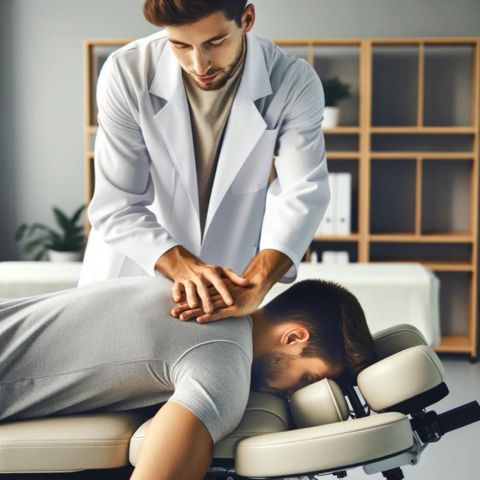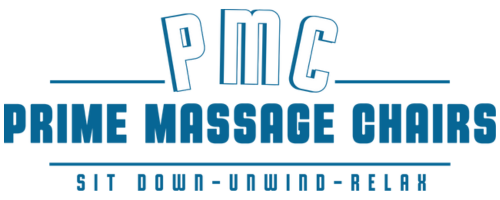
What Is Chiropractic Massage?
What is chiropractic massage and could it be right for you?
This article discusses what it is, the history, the potential benefits and much more!
Now let's get started.
Defining Chiropractic Massage
Chiropractic care and massage therapy are complementary disciplines.
Chiropractors focus on spinal adjustments and joint health, while massage therapists specialize in soft tissue techniques to relieve pain and enhance healing.

This approach helps balance the body's structure and function. It can soothe sore muscles, ease joint stiffness, and support the nervous system.
The focus is on targeting issues at their root cause, often relating to the spine or other joints. Chiropractic massage aims for long-term relief rather than just short-lived comfort.
Now let's dive into how this practice began with a brief history of chiropractic massage.
A Brief History of Chiropractic Massage
Now that we've looked at what chiropractic massage is, let's dive into its past.
The roots of chiropractic care can be traced back to the late 1800s, when Daniel David Palmer performed what is considered the first chiropractic adjustment in 1895. This event is widely acknowledged as a foundational moment in the history of chiropractic care.
As time went on, these practices evolved to include massage techniques for muscle relaxation and pain relief.
Chiropractors began blending traditional adjustments with soft tissue work to enhance results.
They knew that relaxed muscles made spinal adjustments easier and more effective. This combination helped shape today’s chiropractic massage therapy.
Over the years, this approach has gained popularity among people suffering from various pains and ailments.

It has become a key part of holistic healing with devoted followers worldwide.
Although chiropractic care is primarily recognized for treating musculoskeletal issues, ongoing research explores its effectiveness for non-musculoskeletal conditions, with current evidence guiding its application cautiously.
Potential Benefits of Chiropractic Massage Therapy
While some individuals report benefits such as alleviated chronic pain and enhanced joint function from chiropractic massage therapy, it's important to note that outcomes can vary and ongoing scientific research is crucial to fully understand these effects.
Due to the wide variability in health conditions and individual responses to treatment, it's crucial to obtain a personalized assessment from a healthcare professional before initiating any chiropractic care or massage therapy. Individual responses to the following treatments can vary, and not all conditions may respond equally well to the following approach.
Chronic Pain & Fibromyalgia
Chronic pain and fibromyalgia significantly impact daily life, and while some individuals may find relief through chiropractic massage, which targets painful muscles and joints, the effectiveness of this approach can vary and should be considered as part of a comprehensive treatment plan advised by healthcare professionals.
This kind of treatment is all about easing muscle tension and improving joint motion without surgery or drugs.
For individuals with fibromyalgia, some find massage therapy beneficial, reporting reduced stiffness and improved sleep quality. However, it's crucial to note that responses to therapy vary and consulting a healthcare professional is recommended to assess its suitability.
Arthritis
Arthritis, characterized by joint pain and stiffness, can make daily activities challenging. Some individuals with arthritis may experience pain relief and improved movement from chiropractic massage therapy, although outcomes can vary and should be discussed with a healthcare provider.
It works by reducing muscle spasms around joints and increasing blood flow.
Chiropractic massage may help arthritis patients feel less stiff and move better.
Many patients report improved well-being following chiropractic treatments aimed at enhancing spinal alignment, though it's important to note that individual outcomes can vary. Professional evaluation is crucial to determine the efficacy of these treatments for each person.
Patients with arthritis may notice a drop in their pain levels after chiropractic care.
They often find they can do more of their daily activities with less discomfort.
Inflammation & Injuries
Moving from joint issues to soft tissue, chiropractic massage therapy stands as a powerful tool for tackling inflammation and injuries.
It combines hands-on techniques with knowledge of the body's musculoskeletal system to speed up recovery.
Chiropractors often focus on areas around the spine and joints.
Massage during chiropractic care can improve range of motion in stiff limbs or joints. When you have lower back pain or neck pain, these massages can work well alongside spinal manipulative therapy.
This approach helps restore movement and may provide relief from discomfort caused by sports injuries or accidents.
Chiropractic manipulation is intended to address factors contributing to inflammation, with the goal of facilitating natural healing processes. However, the effectiveness of this approach can vary among individuals, and current research is ongoing to better understand its mechanisms and benefits.
These outcomes suggest potential positive impacts on overall well-being, though they merit further exploration and should be considered alongside individual assessments by healthcare professionals.
Understanding the Difference: Chiropractic Care vs. Massage Therapy
Chiropractors focus on the body's structure, mainly the spine. A chiropractor’s goal is to correct alignment problems, ease pain, and support the body's natural ability to heal itself.

Unlike massage therapists who work mostly with muscles, chiropractors might also deal with nerves that can affect overall health.
While massage therapists knead muscles for relief and relaxation, chiropractors perform spinal manipulation therapy. This method involves applying controlled pressure to joints in the spine or other parts of the body.
It may help reduce pain and increase physical mobility. In addition to manipulations, they may use other treatments like electrical stimulation or ultrasound for healing injuries or chronic conditions like sciatica or low back pain.
The Most Popular Chiropractor Massage Tools
In the realm of chiropractic therapy, practitioners employ a variety of tools designed to enhance the massage experience and provide targeted relief.
These instruments are integral to addressing specific musculoskeletal issues and aiding in patient recovery.
The choice of tools and techniques should be based on individual patient assessments and evidence-based practices.
Rollers, Balls & Other Small Tools
Chiropractors often use rollers and balls to help patients feel better. These small tools are great for working on tight muscles and sore spots.
A roller can gently stretch out the body's soft tissues, while a ball can pinpoint harder-to-reach areas.
They press and roll against your skin, moving along muscles to release tension.
Balls come in different sizes to fit various parts of the body, like the back or feet.
Rollers might look simple but they do an important job in chiropractic therapy. They support healthy circulation and can relax stiff muscles quickly.
By using these tools, chiropractors provide relief without needing heavy equipment or complex techniques.
T-Bar Trigger Point Tools
T-Bar Trigger Point Tools are a favorite among chiropractors for their ability to reach deep into muscles and target pain. These tools look simple, but they pack a powerful punch in trigger point therapy.
By pressing on tight spots, they help release tension and ease discomfort. Muscle cramps and backaches don't stand a chance against the precise pressure from T-Bar Tools.
Using these tools involves more than just pressure; it's about strategic placement and movement to promote healing. They mimic deep tissue massage by focusing on exact areas that need relief, like the neck or shoulders.
Patients dealing with headaches or chronic back pain often notice improvements after treatment with these effective instruments.
Body Percussion/Vibration Tools
Chiropractors often reach for body percussion and vibration tools during a treatment. These devices help shake up tight muscles and boost recovery after an adjustment or massage.
Using quick, rhythmic taps, they wake up the body's tissues.
Vibration tools send waves deep into sore spots that hands alone can't touch. They're great for patients who need extra help with pain management or inflammation.
Different Types of Chiropractic Massage Therapy
Explore the diverse techniques within chiropractic massage therapy that address a range of conditions, offering tailored treatments to support your body's healing process and enhance overall wellness.

Craniosacral therapy and cupping are among the diverse techniques utilized within chiropractic massage therapy. It's important to note that these methods are considered part of complementary or alternative medicine, and the level of scientific evidence supporting their effectiveness varies.
Patients interested in these treatments should discuss their options with a healthcare provider to determine the best approach based on current research and individual health needs.
Craniosacral Therapy
Craniosacral therapy gently works on the bones in the head, spinal column, and sacrum. A chiropractor uses this method to ease pain and release tension. It helps by adjusting the flow of cerebrospinal fluid.
This therapy can be calming and often treats problems like chronic headaches and migraines.
If you have stomach aches or feel stressed out, craniosacral therapy might bring relief. Before starting treatment, talk with a chiropractor to see if it's right for you. They will create a plan that fits your needs best.
Though many patients report experiencing benefits from therapies like cupping and craniosacral therapy, it is crucial to acknowledge that the level of scientific evidence supporting these treatments varies.
Consultation with a healthcare professional is essential to evaluate their appropriateness for your specific health needs.
Always consult with a healthcare professional to determine the most appropriate and evidence-based treatment for your specific condition.
Cupping
Moving from the gentle touch of craniosacral therapy, cupping offers a unique approach to muscle and joint issues. In this method, chiropractors place cups on the skin to create suction.
This process can potentially ease muscle tension, improve blood flow, and reduce inflammation. It's a favorite for patients seeking relief from conditions like arthritis or chronic pain.
Cupping has roots in ancient practices but fits well into modern chiropractic care.
The therapy is known for its deep-tissue stimulation which promotes overall health by clearing blockages in the body’s energy pathways.
Myofascial Release
Myofascial release is a special massage therapy for the myofascial tissues. These are the thick, web-like layers that wrap around your muscles. Sometimes they get really tight and cause pain.
This therapy relaxes these layers so you can move better and hurt less.
Your chiropractor will press on your skin, find the areas that feel stiff, and then use gentle pressure or stretching to help loosen things up. It's not just about feeling good; it may help with a lot of problems like back pain or headaches too.
Because everything in your body is connected, treating one area might help another part feel better as well.
Lymphatic Drainage Massage
Lymphatic drainage massage is a key part of chiropractic medicine. This gentle technique helps move lymph fluids through your body.
Chiropractors often use this method to treat patients with different health issues.
During the massage, a chiropractor uses careful, rhythmic strokes. These strokes aim to open up your lymphatic system and improve fluid flow.
People facing conditions like bloating or fibromyalgia may find relief with this therapy.
Lymphatic drainage can be both soothing and healing, helping you feel better overall.
FAQs
Can chiropractic massage help with specific medical issues?
Potentially, chiropractic massage may offer symptom relief for a variety of conditions, such as carpal tunnel syndrome, irritable bowel syndrome (IBS), rheumatoid arthritis, and osteoarthritis, among others. However, the effectiveness can significantly vary, emphasizing the need for a personalized consultation with a healthcare professional.
Who performs chiropractic massages?
Chiropractic adjustments are performed by licensed chiropractors, while massage therapy can be provided by licensed massage therapists. Both professionals work together to deliver integrative care tailored to individual health needs.
Are there different types of massages used in this treatment plan?
Yes. There's a variety from Swedish massage to sports massage that target different problems such as inflammatory conditions or muscle tension caused by repetitive motions.
Does Chiropractic Massage include any other treatments besides hands-on techniques?
Besides hands-on manipulations and foot massages; some plans could involve supplements, cupping therapy or electrotherapy to support recovery and enhance the healing process.
Conclusion
Chiropractic massage blends special touch techniques with spine care. This therapy aims to ease pain and relax muscles without drugs or surgery.
From ancient roots to modern tools, this massage can work well for people of different ages and many health issues.
While chiropractic massage offers numerous potential benefits, it's important to consult with a healthcare professional to determine if it's the right approach for your specific health condition, as individual responses to therapy can vary.
Disclaimer:
We do not provide medical advice. The content of this article, including text, graphics, and other material, is for informational purposes only. It is not intended to be a substitute for professional medical advice, diagnosis, or treatment. Always seek the advice of your physician or other qualified health provider with any questions you may have regarding a health condition. Never disregard professional medical advice or delay in seeking it because of something you have read in this article or on our website.
